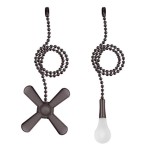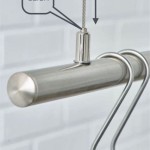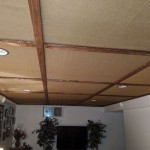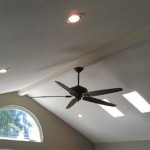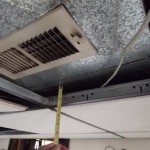Common Ceiling Fan Problems in American Homes
Ceiling fans are a ubiquitous feature in many American homes, providing energy-efficient cooling and air circulation. However, like any mechanical device, ceiling fans are prone to developing problems over time. Understanding these common issues, their potential causes, and troubleshooting steps can help homeowners maintain their fans and avoid costly repairs or replacements. This article explores some of the most frequently encountered ceiling fan problems in American rooms, offering insights into their diagnosis and possible solutions.
Wobbling and Balance Issues
One of the most frequently reported issues with ceiling fans is wobbling. A wobbling fan not only creates an unsightly distraction but can also indicate underlying problems that could worsen over time. The primary cause of wobbling is typically an imbalance in the fan blades. This imbalance can arise from several factors, including manufacturing discrepancies, blade warping, dust accumulation, or loose hardware.
Over time, dust and debris can accumulate unevenly on the blades, creating a weight differential that causes the fan to wobble. Regular cleaning of the blades, ensuring even distribution of weight, can often rectify this issue. Simple dusting with a damp cloth or microfiber duster is usually sufficient to remove accumulated dust. For more stubborn dirt or grease, a mild detergent can be used, followed by a thorough rinse and drying.
Another common cause is loose hardware. The screws that attach the blades to the motor housing can loosen over time due to vibration. Regularly checking and tightening these screws is a crucial maintenance task. Use a screwdriver to carefully tighten each screw, being careful not to overtighten them, as this could strip the screw threads or damage the blade assembly. If the screws are stripped or damaged, they should be replaced with appropriately sized replacements.
In some cases, the blades themselves might be warped or damaged. Warping can occur due to changes in humidity or temperature, especially if the blades are made of wood or a composite material. Examine each blade carefully for any signs of warping, bending, or cracking. If a blade is significantly damaged, it should be replaced. Replacement blades are typically available from the fan manufacturer or from home improvement stores. When replacing blades, it is crucial to replace them in a set to maintain balance. Mixing different blade types or brands can exacerbate the wobbling problem.
Balancing kits are also available to address wobbling issues. These kits typically include small weights that can be attached to the blades to counteract the imbalance. The instructions included with the kit will guide the user on how to strategically place the weights on the blades to achieve optimal balance. This process often involves trial and error, incrementally adjusting the placement of the weights until the wobbling is minimized or eliminated. The balancing kit is often the first recourse for homeowners who are encountering wobbling problems.
Finally, the mounting bracket itself can contribute to wobbling if it is not securely attached to the ceiling. Ensure that the mounting bracket is firmly screwed into a ceiling joist, which is a structural support member in the ceiling. If the bracket is attached only to drywall, it may not be able to support the weight of the fan, leading to wobbling. In such cases, the bracket should be re-mounted to a joist, or a fan-rated electrical box designed to support the weight of the fan should be installed. This might require professional assistance.
Motor Humming and Noise
Ceiling fan motors can sometimes produce a humming or buzzing noise, which can be disruptive and indicate a potential problem. The causes of motor noise are varied, ranging from loose components to issues with the motor itself.
One of the most common causes of motor humming is loose hardware. As with blade wobbling, loose screws and bolts can vibrate and generate noise. Check all screws and bolts associated with the motor housing, the blade brackets, and the mounting bracket. Tighten any loose hardware to see if the noise diminishes. If the noise persists after tightening all visible hardware, further investigation may be necessary.
Another potential cause of motor humming is a lack of lubrication. The motor's internal components require lubrication to operate smoothly and quietly. Over time, the lubricant can dry out, leading to increased friction and noise. Some ceiling fans have lubrication ports that allow for the addition of oil. The manufacturer's instructions should be consulted to determine the appropriate type of oil to use and the correct procedure for lubrication. If the fan does not have lubrication ports, it may be necessary to disassemble the motor housing to lubricate the internal components. This is a more complex task and may be best left to a qualified electrician.
In some cases, the motor humming can be caused by electrical issues. A faulty capacitor, which is a component that helps start and run the motor, can produce a humming noise. Capacitors are relatively inexpensive and can be replaced. However, identifying a faulty capacitor requires some electrical knowledge and the ability to safely disconnect and test the component. If you are not comfortable working with electrical components, it is best to consult a qualified electrician.
A less common, but more serious cause of motor humming is a worn-out motor. Over time, the motor's bearings and windings can deteriorate, leading to increased noise and reduced performance. If the motor is significantly worn, it may be more cost-effective to replace the entire fan rather than attempting to repair the motor. Replacement motors can be difficult to find and install, and the cost of labor can be significant.
The type of speed control used can also influence the noise generated by the fan. Some dimmer switches are incompatible with ceiling fan motors and can cause a humming noise. Ensure that the speed control is specifically designed for use with ceiling fans. A standard rheostat-style dimmer switch is often the culprit and should be replaced with a fan-rated speed control.
Lighting Issues
Many ceiling fans incorporate integrated lighting fixtures, which can also be a source of problems. Common lighting issues include flickering, dimming, or complete failure of the lights. Diagnosing and resolving these problems requires understanding the different components of the lighting system.
The simplest cause of lighting problems is a burnt-out light bulb. Check the light bulb first and replace it with a bulb of the correct wattage and type. Ensure that the new bulb is securely screwed into the socket. If the light still does not work after replacing the bulb, the problem may lie elsewhere.
Loose connections are another common cause of lighting issues. Check all the wiring connections associated with the light fixture, including the connections in the light kit itself, the connections in the switch housing, and the connections in the ceiling electrical box. Make sure that all connections are secure and that there are no loose wires or corroded terminals. Turn off the power at the circuit breaker before inspecting or working on electrical connections.
Flickering lights can also be caused by a loose wire nut in the switch housing or the ceiling electrical box. Carefully inspect the wire nuts to ensure that they are tightly secured and that the wires are properly twisted together. If a wire nut is loose or damaged, replace it with a new one.
In some cases, the light fixture itself may be faulty. The light fixture may contain a ballast, which is a component that regulates the voltage to the light bulb. If the ballast is faulty, it can cause the light to flicker, dim, or fail completely. Replacing the ballast can be a complex task and may require a qualified electrician.
Some ceiling fans use remote controls to operate the lights and fan speed. If the remote control is not working properly, it can cause problems with the lights. Check the batteries in the remote control and replace them if necessary. Also, make sure that the remote control is properly paired with the fan receiver. The pairing process typically involves pressing a button on the receiver and then pressing a button on the remote control. Consult the fan's instructions for the specific pairing procedure.
Another possible cause of lighting problems is a faulty pull chain switch. The pull chain switch controls the power to the light fixture. If the switch is worn or damaged, it can fail to make proper contact, causing the lights to flicker or not work at all. Replacing the pull chain switch is a relatively simple task that can be performed by a homeowner with basic electrical knowledge.
Finally, the issue could also lie with the building wiring or the circuit breaker. Ensure the circuit breaker is not tripped. If the circuit breaker is tripped, reset it. If the circuit breaker trips repeatedly, there may be a short circuit in the wiring, which needs professional attention.

How To Troubleshoot Your Ceiling Fan The Home Depot

How To Replace An Old Ceiling Fan Full Installation Wiring Guide Builds By Maz

Ceiling Fan Wikipedia

How To Replace A Ceiling Fan Ask This Old House

Improving Ventilation In Your Home

Ceiling Fan Rpm Meaning Factors Affecting Sped Crompton

Why Is My Ceiling Fan Not Responding To The Remote Home Improvement Stack Exchange
Hunter Aa 52 Led Ceiling Fan Costco

How To Replace A Capacitor In Ceiling Fan 3 Ways

Fan Wikipedia
Related Posts

